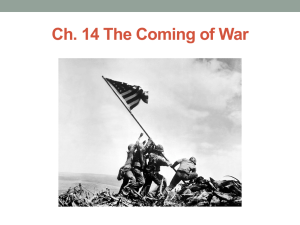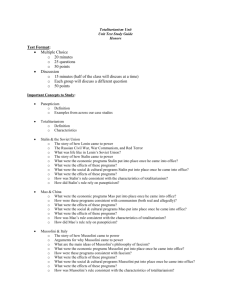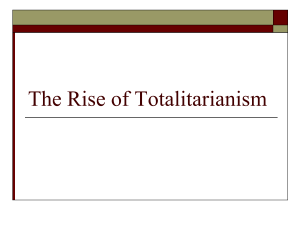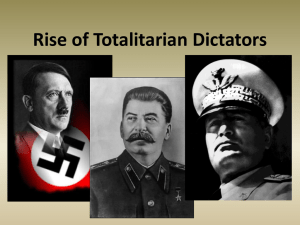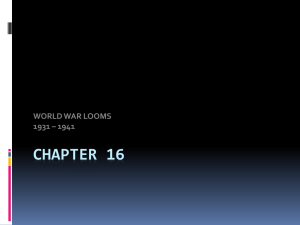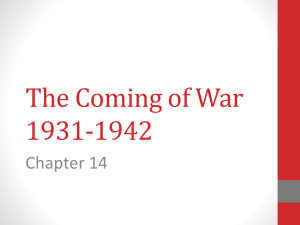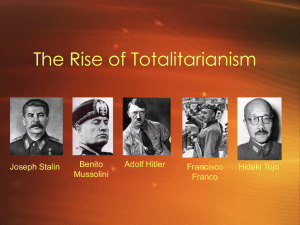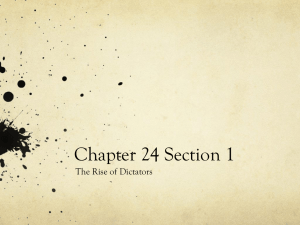World War II
advertisement
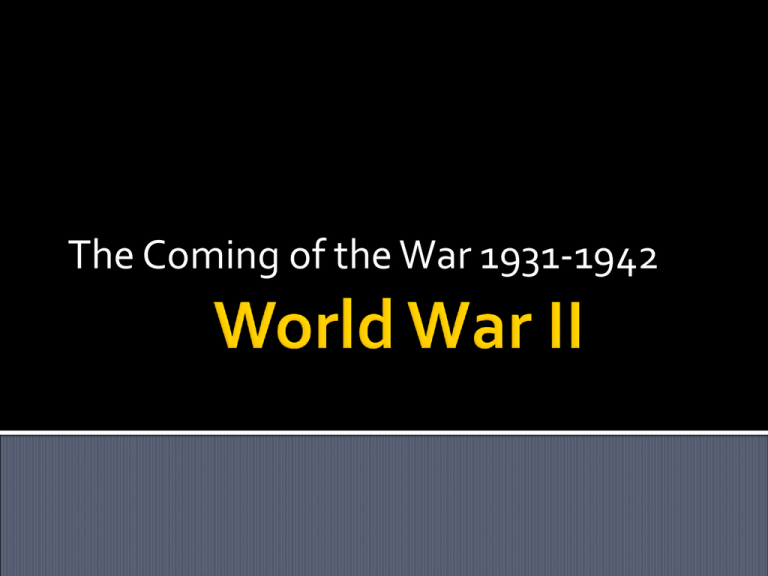
The Coming of the War 1931-1942 DEMOCRACY During the 1920’s many nations moved toward freedom and democracy. Some nations took a different direction and moved toward repressive dictatorships and totalitarianism governments. TOTALITARIANISM Totalitarian governments is a theory of government in which a single party or leader controls the economic, social, and cultural lives of its people. The Soviet Union and Italy were two countries that adopted repressive governments. USSR In 1924, Lenin died and Joseph Stalin took over as the leader in USSR. Stalin means “Man of Steel” in Russia Cruel and Ruthless He wanted to transform the USSR into an “industrial power” and “state run collective farms.” STALIN CONTINUED The “State ran industrial power” led to 10 million deaths of his own people. Stalin used fear, propaganda and terror to control his people It is believed that he used the Red Army to imprison and kill up to 10 million additional people. MUSSOLINI IN ITALY Benito Mussolini formed the Fascist Party which was a right winged organization that trumped nationalism and promised to make Italy great again. The followers of Mussolini were known as the Black Shirts. MUSSOLINI CONTINUED Mussolini took control over the government and the army within a few years. He outlawed political parties. He took over the press. He created the secret police. He organized youth groups that he could use to indoctrinate the young. TOTALITARIANISM A theory of government in which a party or leader controls the economic, social and cultural lives of people. CHARACTERISTICS OF TOTALITARIANISM Single party dictatorship controls every aspect of life Strong, charismatic leader State ran economy Use of police and spies to enforce terror Government control of the media Use of schools and youth to spread ideology Strict censorship of artist GERMANY Germany was weakened by the worldwide effects of the Great Depression. Adolf Hitler started the Nazi Party. He wrote a book called Mein Kampf which means “ My Struggles.” In his book he stated the reasons he felt that Germany had problems. HITLER Hitler criticized the ideologies but his sharpest assaults were against the communist and the Jews. He spread pseudoscientific theories of a master race that targeted the Jews for future violence. Hitler was the symbol of a totalitaranian regime. HITLER He used the secret police to crush all opposition. He ran a state controlled press-propaganda. The state controlled press praised/worshipped Hitler’s accomplishments. He had a state controlled educational system to indoctrinate the youth. HITLER IN LATE 1930’S He violates the Versailles Treaty that ended World War I and starts rearmament or rebuilding the military. His economic policies and public works projects ended the Great Depression in Germany. JAPAN During the 1920’s Japan increased the freedoms and democracy. The Japanese government reduced the size of the military. Japan passed laws giving all men the right to vote. Japan legalized trade unions. JAPAN Japan allowed diverse political parties to develop. Japan did not become a totalitarianism state. Japan continued as a constitutional monarchy. NAZI JAPAN EXPANDS EMPIRE Japans power shifted and turn toward military control. Japan started a period of military expansion. Japan moved to control Chinese railroads. Japanese were violent killing over 200,000 and burning city “Rape of Nanking.” WEAKNESSES OF LEAGUE OF NATIONS America refused to join. League had no standing army and no real power. Aggressive nations challenged the League and it was short on action. HITLER Hitler violated the Treaty of Versailles and increased the size of the army and navy. He spoke to the German people about needing “living space.” In 1935 he reclaimed the Saar a region the French controlled. The League did nothing. MUSSOLINI 1935 Mussolini lead Italy to invade Ethiopia, an independent country in east Africa. Emperor Haile Selessie appealed to the League and they did almost nothing. Ethiopia fell to Italy. 1936-1939 Spain was in a civil war. Both Hitler and Mussolini sent aid to the nationalist. The USSR sent aid to the republican side. APPEASEMENT POLICY Why did Britain allow appeasement? WWI had been horrific. Many countries, including USA and FDR, did not take hard stance against German aggression. HITLER & AGGRESSION Hitler takes Sudetenland. Britain and France appease Germany. Appeasement under Munich Pact only postponed the war 11 months. Munich Pact Hitler would take part of Czechoslovakia but not all of it. He was ended his aggression. This was not an effective pact. NAZI ROOSEVELT OPPOSES AGGRESSION The Rape of Nanking and the killing of 3 navy sailerPanay Incident…ships sunk. FDR made a statement on Japan “reign of terror and u FDR CRITICIZED JAPANESE AGGRESSION. At the beginning of the war, the majority of Americans were in position the war. Many Americans were not over World War I and thought it was an expensive mistake. NEUTRALITY ACT OF 1939 The Neutrality Act of 1939 contained a cash-n-carry policy . FDR had been selling items to democracies in Europe but also sold to belligerent nations if they paid cash and carried their items purchased on their own ships. FDR was pro-Allies. TRIPARTE PACT 1940 The Triparte Act was an alliance signed in September 1940 between Germany, Italy and Japan. This caused Congress to pass the Selective Service Act which provided the military with 1.2 million troops and 800,000 reserve troops. LEND-LEASE ACT America passed the Lend Lease Act was passed and authorized FDR to sell, transfer title to, exchange, lease, lend or otherwise to dispose of any such government that was a threat to the defense of the USA. THE ATLANTIC CHART German u-boats USS Rubuen James USS Greer USS Kearney FDR gave a speech called the Four Freedoms. Freedom of speech and expression, freedom of religion, freedom from want and freedom from fear. A shadow has fallen upon the scenes so lately lighted by the Allied victory…an iron curtain has descended across the continent. Behind that line lie all the capitals of the ancient states of Central and Eastern Europe. — Winston Churchill In the quotation above, Winston Churchill described the — A economic problems facing Europe following World War II. B need to rebuild the defensive fortifications of pre-World War II Europe. C forced separation of Europe into communist and democratic nations. D collapse of organized government in communist-controlled areas in Europe.


